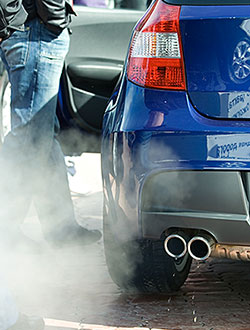Future Challenges for Catalytic Vehicle Emission Control
By Chuck Peden

The abatement of environmentally harmful compounds–(hydrocarbons (HC), oxides of nitrogen (NOx) and sulfur (SOx), and carbon monoxide (CO)–emitted from mobile or stationary power sources has been a remarkable success story for the catalysis R&D community [1]. In particular, for vehicle exhaust emission control applications, the "three-way" catalyst that is the active material of the catalytic converter–a standard component on automobiles in the United States and Europe for more than 30 years–has contributed to a remarkable drop in emissions of CO, HC, and NOx from gas-powered vehicles. We now take for granted the dramatic improvements that the introduction of the catalytic converter technology has made in air quality and, correspondingly, human health.
Unfortunately, the three-way catalytic converter technology is unsuitable for application on "lean-burn" engines that operate at high air/fuel ratios, including diesel-powered vehicle engines. Although these engine technologies are inherently more fuel-efficient than "stoichiometric" gasoline engines, their widespread use in vehicles has been limited by the catalyst's inability to reduce NOx emissions at these high air/fuel ratios.
As such, in the last 10 to 15 years, significant R&D focus has been on this problem of lean-NOx emission control, and considerable research in this area has been carried out in the Institute for Integrated Catalysis (IIC) at PNNL. This R&D, with much of it sponsored by the Department of Energy's Vehicle Technology Office, has culminated in the very recent commercialization of two new nano-materials-based catalytic emission control applications for diesel-powered vehicles: the NOx storage/reduction (NSR) catalysts and the selective catalytic reduction (SCR) with ammonia using metal-exchanged zeolites [2].
Importantly, however, because these are such newly introduced technologies, several research challenges remain to improve performance, enhance stability, and lower costs. Indeed, many practical concerns with these new lean-NOx catalyst technologies stem from a relatively poor fundamental understanding of catalyst structure and activity and reaction mechanisms. For this reason, IIC research aimed at developing this fundamental understanding continues.
Looking to the future, novel operating modes for internal combustion engines (ICEs) are being researched to meet the very stringent new demands for fuel efficiency (e.g., U.S. Corporate Average Fuel Economy standards for average miles per gallon are scheduled to increase dramatically over the next 10 to 15 years). These new ICE engine operation modes, while highly fuel-efficient, result in much lower exhaust temperatures than current engines–temperatures so low it is hard to imagine how current catalytic emission control technologies will be able to function [3]. Thus, both evolutionary and revolutionary technology development challenges can be foreseen for the catalyst R&D community.
Indeed, the catalytic vehicle emission control R&D community is now at the earliest stages of a third era. Having achieved remarkable success in developing the three-way catalytic converter (Era 1) and lean-NOx catalyst technologies (Era 2), the community now faces this daunting challenge of providing new catalyst materials and processes that can effectively eliminate emissions at these quite low (~150°C) exhaust temperatures.
While recent fundamental catalysis science has identified some potentially useful catalyst systems, a major R&D effort will still be needed over at least the next 10 years to realize commercially viable catalyst technologies. As has been the case for the last 15 years, the IIC expects to play a major role in overcoming these low temperature catalysis challenges and, in fact, we are just now initiating several new programs that were recently funded in the IIC by the DOE's Vehicle Technology Office.
References
- R.M. Heck and R.J. Farrauto, Catalytic Air Pollution Control: Commercial Technology. Van Nostrand Reinhold (New York) 1995.
- A. Yezerets, C.H.F. Peden, J. Szanyi, I. Nova, and W.S. Epling, Editors, Special Issue on Mobile Emissions Control. Catalysis Today
184, 2012. - M. Zammit, C.L. DiMaggio, C.H. Kim, C.K. Lambert, G.G. Muntean, C.H.F. Peden, J.E. Parks, and K. Howden, "Future Automotive Aftertreatment Solutions: The 150°C Challenge Workshop Report." U.S. Drive Report (Southfield, MI), PNNL-22815, 2013.
Dr. Charles H.F. (Chuck) Peden is associate director of the Institute for Integrated Catalysis at Pacific Northwest National Laboratory. His research interests are focused on the heterogeneous catalytic chemistry of metals and oxides, and Chuck has an international reputation for his studies of catalyst structure and the reaction mechanisms of automobile exhaust catalytic processes.

